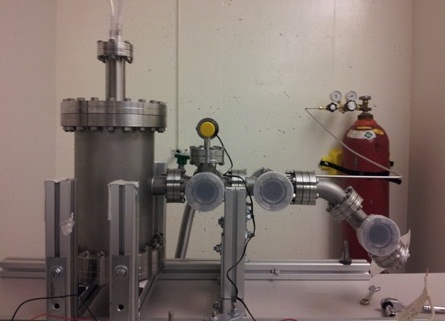Vacuum System
The vacuum system has two main functions. On one side it is required to minimize energy loses of the accelerated electrons and on the other side it avoids sparking of the accelerating circuit. To satisfy these two constraints a maximal pressure of 100 mtorr is allowed. Further, controlled injection of gases (e.g. Helium) is possible.
Description
A rotary vane mechanical pump reaching a pressure of 4x10e-3 torr is used for this project. All the vacuum tubing material is made from 304L Stainless Steel. The size of the flanges for the crosses and tubes is 2.75in.
 Overview of the vacuum system. On the left is located
the chamber for the accelerating circuit.
Overview of the vacuum system. On the left is located
the chamber for the accelerating circuit.
|
CF flanged tubes were chosen for their capacity to withstand low pressures of 10-12 torr, giving the team a flexible design that facilitates future improvements in the system (such as adding turbo-molecular pump). In order to be able to seal the vacuum system as the pump is turned off, a diaphragm valve is used. Similarly, in order to re-pressurize the system back to 1 atm, an up to air valve is used.
Pressure inside the system is meassured with a convection enhanced Pirani pressure gauge (1000 torr to 1x10e-4 torr). The model selected is the CVM211 Stinger designed by Instrutech Inc. The gauge comes with a built-in display providing a digital reading of the pressure and ease of use. It also connects to a power supply that uses a 9-pin connector and provides DC power. In case of Helium inside the system, the readings are corrected accordingly.Beam visualisation
During testing of the system, phosphorous is used for visualising the electron beam (when the electrons collide with phosphorous, blue color is emitted). The beam can be seen through three glass viewports connected to the flanges of the vacuum system. The viewports are made out of Kodial Glass. Glass viewports showing the inside of the vacuum system
Glass viewports showing the inside of the vacuum system
|
